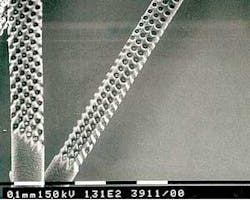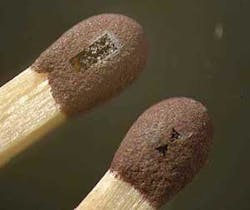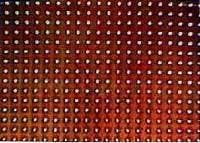Understanding ultraviolet lasers
MARTIEN VAN DIJK
The word “laser” can mean different things to different people, depending on their experience or specific knowledge. They may be familiar with one of the industrial applications like drilling, cutting, or welding. Perhaps they know about eye corrections by laser or have visited a laser light show. But I wonder how many know that the marks on drugs they may be using are made by laser, that advanced safety features on ID and credit cards are made by laser, or that eyeglasses have almost invisible marks made by laser. The lasers used for these applications are ultraviolet (UV) lasers that generate light with wavelengths in the range of 150 to 400 nm.
UV lasers are well suited for micro-scale applications. These include the following:
- Engraving of precision tools for stamping or micro-spark erosion
- Marking of glass and synthetics whereby the surface isn’t changed in structure or chemical composition
- Drilling of small holes in diesel fuel injectors
- Cleaning of old painting without attacking the original paint layers
In structuring of surfaces these lasers fill the gap between lithographic techniques as used in integrated circuit (IC) fabrication and mechanical micromachining and micro-spark erosion.
What makes them so well suited for micro-drilling, micro-structuring, and cleaning old paintings? Their short wavelength allows small, focused spot sizes. Short pulsewidths and high intensities result in material removal where every pulse removes only a small amount of material, therefore allowing the production of well-defined microstructures. The beam intensity is so high that the material is removed in the vapor phase in a process called ablation, the end result of which is a clean surface.What makes them so well suited for marking synthetics and glass and for creating safety features on ID and credit cards? Again the short wavelength is important because the small spot size allows penetration into the material where chemical and or physical transitions will result in changes that can be observed either by the naked eye or under special light or with proper magnification.
Many of these applications require the user to have proper know how about UV lasers and also about optics and the material to be processed. Manufacturers of UV lasers and specific companies with facilities for application research are helping industry to develop new processes using these lasers.
There are three main types of UV lasers. The first is a solid-state, Q-switched Nd:YAG laser where a special crystal is used to change the infrared 1064 nm wavelength to the ultraviolet 353 nm wavelength. The beam shape is Gaussian, so the spot will be round with the energy intensity falling off gradually from the center to the edge. Due to the short wavelength and the limited beam quality, the beam can be focused to spot sizes on the order of 10 µm. In principal, like all solid-state lasers these ultraviolet lasers are sensitive to temperature variations. Up to 30 minutes may be needed to establish sufficient stability after a cold start. Therefore these lasers will normally have a special standby condition where all critical components are kept at the operation temperature. The high repetition rate and the small focused spot make these lasers well suited for machining on a micro scale.The second type of UV laser is a gas laser, the excimer laser. The wavelength of this laser depends on the type of gas mixture used. The beam generated isn’t round but has a rectangular shape with an intensity distribution more or less constant over the cross section of the beam that falls off sharply at the edges. Masks can be used to generate specific spot geometries. Process details can be as small as a few microns, while the distance between focusing optics and workpiece can be as large as 50 to 100 mm. Holograms may also be used to generate specific beam energy patterns.
The third type of UV laser is the metal vapor laser. The copper vapor laser is mainly used although vapors of several other metals can also be suitable. Copper vapor lasers generate radiation at 511 nm and 578 nm wavelength. Frequency mixing and doubling are use to generate ultraviolet radiation with 255 nm, 271 nm, and 289 nm wavelength. The beam shape is Gaussian, which makes the laser well suited for the same range of applications as the solid-state ultraviolet laser.
Like all other types of lasers ultraviolet lasers are suited for a specific field of applications. They are well suited for applications on a micro scale with high quality results. This has opened a wide range of new applications for which there is no alternative technology. It is certain that in the future we will see a number of new applications that we haven’t even thought of today. The relatively low processing rate, compared to visible and infrared laser radiation, will challenge the laser manufacturers to develop lasers with higher average powers. This will help to reduce the costs of the technology.
Excilas
In 1995 Hans van Esdonk left the Philips Center of Manufacturing Technology where he had been a specialist in the application of excimer lasers. His company, Excilas, serves companies in southeast region of the Netherlands in addition to companies in other European countries, Asia, and the U.S. The company prefers to work in projects with well-defined phases and deliverables.
Thanks to his Philips background, van Esdonk has an extended network of high-tech partners so the company is well suited to serve other companies in finding an optimum solution for production problems. The service may range from application research through design and development of production systems to transfer of know how.
The company has two excimer lasers. They can be filled with different gas mixtures to choose the best wavelength for a specific application.
According to van Esdonk, beside an interest from the micromachining industry there is an increase in interest in biomedical applications where the short wavelength and the short pulses of ultraviolet lasers are of benefit.
Lasertec
The Dutch company Lasertec, located in Barendrecht near the city of Rotterdam, will celebrate its 10th anniversary this year. As one of the first companies to use solid-state ultraviolet lasers it has broad experience in development of special processes. Over the years it has built working relations with specialists in design and manufacturing of production units and also with the manufacture of synthetics. Through these relationships the company can supply customers with turnkey solutions.
The main services the company provides are laser engraving of precision tools; direct laser marking of metals, glass, and synthetics; application research in new methods to compliment conventional manufacturing technologies; development of ultraviolet-based production process; and preventive maintenance of ultraviolet laser systems. According to the director of the company, Marco Bak, the company can also take full process responsibility.
It has five solid-state ultraviolet lasers that are used for application research and job shop activities.
More information on the company can be found on its website, www.lasertec.nl.


